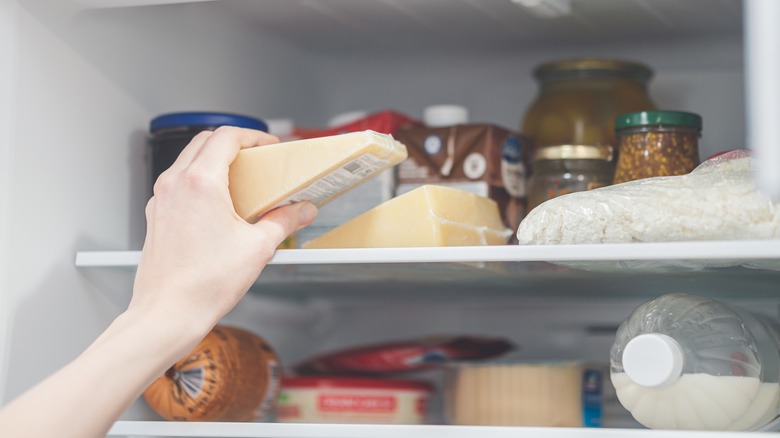Your Fridge Probably Has A Cheese Drawer. Here's How To Find It
If you're like many of us, one space in the refrigerator seems as good as another for storing groceries — but did you know that the different sections of your fridge are not one-size-fits-all? You likely know about the produce drawer, but depending on its design, your fridge may also have a narrow compartment specifically designed for cheese and other deli products. This slim drawer, separate from the vegetable crisper, tends to be smaller in width and height.
According to the USDA, this designated compartment directs cold air into the drawer "to keep items very cold without freezing," thereby prolonging your cheese and meat storage time. When cheese — especially a less-aged, softer variety — is exposed to the dehydrating airflow of the fridge, it can lose its ideal texture and flavor.
If your fridge doesn't have a dedicated deli drawer, you can still store cheese in the vegetable or fruit crisper, as these compartments are designed to stabilize humidity. Just be aware that the worst part of your fridge for storing cheese is in the door, as items stored there are subject to fluctuating temperatures every time you open and close it.
How to package cheese in your fridge
Storing your cheese in the correct drawer is the first step to keeping it fresh and delicious, but did you know that the material you choose to wrap your cheese in matters too? Cheese paper, which consists of a fusion of wax-coated paper and plastic layers, is one of the best materials for wrapping and refrigerating your cheese.
The two layers work in concert to trap moisture but prevent condensation buildup, protecting your cheese without suffocating it.
Most types of cheese should not be stored in tight plastic wrap, as this restricts airflow and prevents the cheese from releasing natural gases, like ammonia. When cheese cannot release gases, it can develop unpleasant flavors and smells. Additionally, plastic wrap seals in moisture, which can make your cheese taste sour or degrade its quality.
While you should always opt for cheese paper if possible, wrapping your cheese in aluminum foil — which helps prevent light exposure when you open and close the fridge, and can accelerate the breakdown of fats in cheese — is still preferable to plastic wrap.
How long do different cheeses last in the fridge?
The cheese world is abundant with variety, each type offering different flavors, textures, and shelf lives. To determine how long your particular wedge will last, there are a few general guidelines to help you enjoy your cheese when it's at its peak and minimize waste.
When unopened, you can store hard, dry cheeses (such as cheddar, Swiss, or parmesan) in the fridge for up to six months. Once opened, they remain delicious for three to four weeks. In contrast, soft, wet cheeses — like Brie, ricotta, or cottage cheese — only stay fresh in the fridge for about one week after opening.
Hard, dry types of cheese last longer because they contain less moisture and have a higher salt content. The lack of moisture creates an unfriendly environment for bacterial growth, and salt acts as a natural preservative. However, if you can't finish hard cheese in time, you can freeze it for up to six months. Technically, you can also freeze soft cheese, but its higher water content often compromises the texture once defrosted.
If you don't have room in your fridge, it's possible to keep certain hard, dry cheeses, like parmesan or aged cheddar, in their original packaging at room temperature. However, dry cheeses can only be stored outside the fridge for about one to 10 days, provided the temperatures aren't excessively high.



